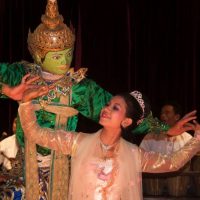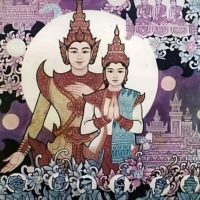Yama : The Burmese Rama and Embodiment of Virtue
Listen
At a glance
| Description | |
|---|---|
| Origin | Burmese Mythology |
| Classification | Gods |
| Family Members | Letkhana (Brother), Thida (Wife) |
| Region | Murma (Myanmar) |
| Associated With | Royalty, Virtue |
Yama
Introduction
In Burmese mythology, the figure known as Yama is the Burmese name for Rama, the heroic prince from the Ramayana. Unlike Indian mythology, where Yama is the god of death, the Burmese Yama is entirely distinct—he represents the noble avatar of Vishnu, celebrated for virtue, loyalty, and moral strength. His story survives through Yama Zatdaw, Myanmar’s national version of the Ramayana, which has evolved since at least the Pagan era in the 11th century. This adaptation blends Hindu epic structure with Theravada Buddhist ethics and Burmese artistic traditions, creating a version of Rama that is deeply rooted in Myanmar’s cultural identity. Yama’s story is performed in dance-drama, preserved in temple murals, and referenced in folk expressions, making him one of the most recognizable mythological heroes in Myanmar.
Physical Traits
Yama’s appearance in Burmese tradition reflects his status as a divine prince whose virtues are revealed through his poise and serenity. In Yama Zatdaw performances, he is dressed in elaborate royal garments decorated with gold filigree, silk fabrics, and ornate jewellery typical of Burmese court attire. His crown, known as the mahālatā, marks his celestial lineage and highlights his role as a future king. While his physique signifies athletic ability, his overall portrayal is calm and composed rather than aggressive; the Burmese aesthetic prefers subtle strength over overt masculinity. His iconic bow symbolizes divine authority, and in classical dance movements his gestures embody patience, humility, and the inner discipline expected of an ideal ruler in both Hindu and Buddhist traditions.
Family
The family of Yama remains faithful to the structure of the original Ramayana, though expressed with linguistic and cultural variations. He is the son of King Dasaratha and Queen Kausalya, born into the prestigious Ikshvaku dynasty. His relationship with his brothers—Lakshmana (Letkhana), Bharata, and Shatrughna—is a central pillar of the narrative, demonstrating unity and commitment to dharma. His wife, Thida (Sita), is revered for her unwavering devotion, and her abduction by the demon king Dathagiri (Ravana) sets the emotional core of the story. Burmese storytelling emphasizes the loyalty of Letkhana, who accompanies Yama throughout his exile, creating a model of brotherhood that resonates with Burmese social ideals. These relationships reinforce the principles of familial duty, compassion, and moral responsibility that lie at the heart of Burmese interpretations of the epic.
Other names
The Burmese adaptation introduces several localized names that highlight how the Ramayana was reshaped to match Myanmar’s linguistic and cultural landscape. Yama is one such transformation—an adaptation of Rama’s name into Burmese phonology. His wife Sita becomes Thida, projecting a softer Burmese cadence, while Lakshmana transforms into Letkhana, retaining the essence of the original name. Ravana is known as Dathagiri, reflecting local mythic naming styles. Yama is also occasionally referred to in Buddhist interpretive contexts as Alaung-daw Yama, a title that aligns him with bodhisattvic ideals and associates him with the future Buddha, reflecting deep syncretism between Hindu epic tradition and Burmese Buddhist doctrine. Despite these variations, the spiritual identity of Yama as Vishnu’s avatar is always preserved.
Powers and Abilities
Yama’s abilities are grounded in his spiritual purity and his role as the upholder of righteousness. While he possesses exceptional archery skills and the strength required to defeat supernatural adversaries, Burmese tradition frames his power less in terms of physical dominance and more through ethical authority. As an avatar of Vishnu, he carries divine purpose, making his actions embodiments of cosmic duty. His leadership, patience, and discernment are viewed as his greatest strengths, cultivated through his dedication to dharma. In Yama Zatdaw performances, these qualities are expressed through disciplined movements, refined gestures, and symbolic choreography rather than exaggerated displays of supernatural feats. His victory over Dathagiri represents not only the triumph of good over evil but also the triumph of moral clarity over desire and deception—an interpretation strongly aligned with Buddhist values.
Modern Day Influence
Yama remains an enduring cultural figure in Myanmar, occupying a unique place at the intersection of history, religion, and performance. The Yama Zatdaw continues to be staged during cultural festivals, especially Thingyan and pagoda celebrations, allowing new generations to experience the epic through traditional dance and dramatic art. Burmese artists have depicted scenes from the epic in temple murals, lacquerware, manuscript illustrations, and modern graphic art, demonstrating its continual reinterpretation. In education and Buddhist sermons, Yama’s story is often referenced to highlight moral principles such as loyalty, truthfulness, and restraint. His narrative also influences proverbs and idioms, shaping everyday expressions of virtue and duty. Despite Myanmar’s changing social landscape, Yama remains a powerful symbol of moral kingship, cultural heritage, and the enduring bond between Indian and Burmese civilizational traditions.
Related Images
Source
Arup K. Chatterjee. (2024, July 15). The Different Types Of Ramayanas Of Southeast Asia. https://arupkchatterjee.com/2024/07/16/the-different-types-of-ramayanas-of-southeast-asia/
Kaung, U. T. (n.d.). The Ramayana Drama in Myanmar. https://www.uclmyanmar.org/wp-content/uploads/2016/01/8-The-Ramayana-Drama-in-Myanmar.pdf
Wikipedia contributors. (2023). Ramayana. Wikipedia. https://en.wikipedia.org/wiki/Ramayana
Wisdom Library. (2022, March 16). Yama-Pwe or The Ramayana Play in Burma. https://www.wisdomlib.org/history/compilation/triveni-journal/d/doc68137.html
Washington University. (2018, March 5). The Ramayanas of Southeast Asia. https://jsis.washington.edu/csead/resources/educators/ramayanas-of-southeast-asia/
Wikipedia contributors. (2023). Yama Zatdaw. Wikipedia. https://en.wikipedia.org/wiki/Yama_Zatdaw
Lord Rama. (2009, December 31). Ramayana in different countries. http://lordrama.co.in/ramayana-in-different-parts-of-the-world.html
Sarkar, S. (2012). The Ramayana in Southeast Asia: Cultural adaptations and transformations. Routledge.
Doniger, W. (1999). Hindu myths: A sourcebook translated from the Sanskrit. Penguin Classics.
Tin Maung, T. (2015). Dance-drama traditions in Myanmar: The Yama Zatdaw. Asian Theatre Journal, 32(1), 45–67.
Strong, J. S. (2005). The Buddhist cosmology: From India to Southeast Asia. Princeton University Press.
Khin Zaw, M. (2008). Burmese Buddhist cosmology and the role of epic adaptations. Journal of Southeast Asian Studies, 39(2), 215–230.
Frequently Asked Questions
Who is Yama in Burmese mythology?
Yama is the Burmese name for Rama from the Ramayana, celebrated as a divine prince and symbol of righteousness.
Is Yama in Myanmar the same as the Indian god of death?
No. In Myanmar, Yama refers to Rama the hero, not the Indian god of death.
What is Yama Zatdaw?
Yama Zatdaw is Myanmar’s national version of the Ramayana, performed in dance-drama and storytelling traditions.
Why is Rama called Yama in Burmese tradition?
The name results from linguistic adaptation and local pronunciation as the Ramayana spread into Myanmar.
How is Yama represented in Burmese art and culture today?
He appears in classical dance, temple murals, modern artworks, and cultural teachings focused on morality and virtue.







